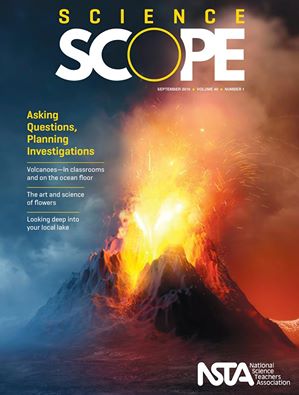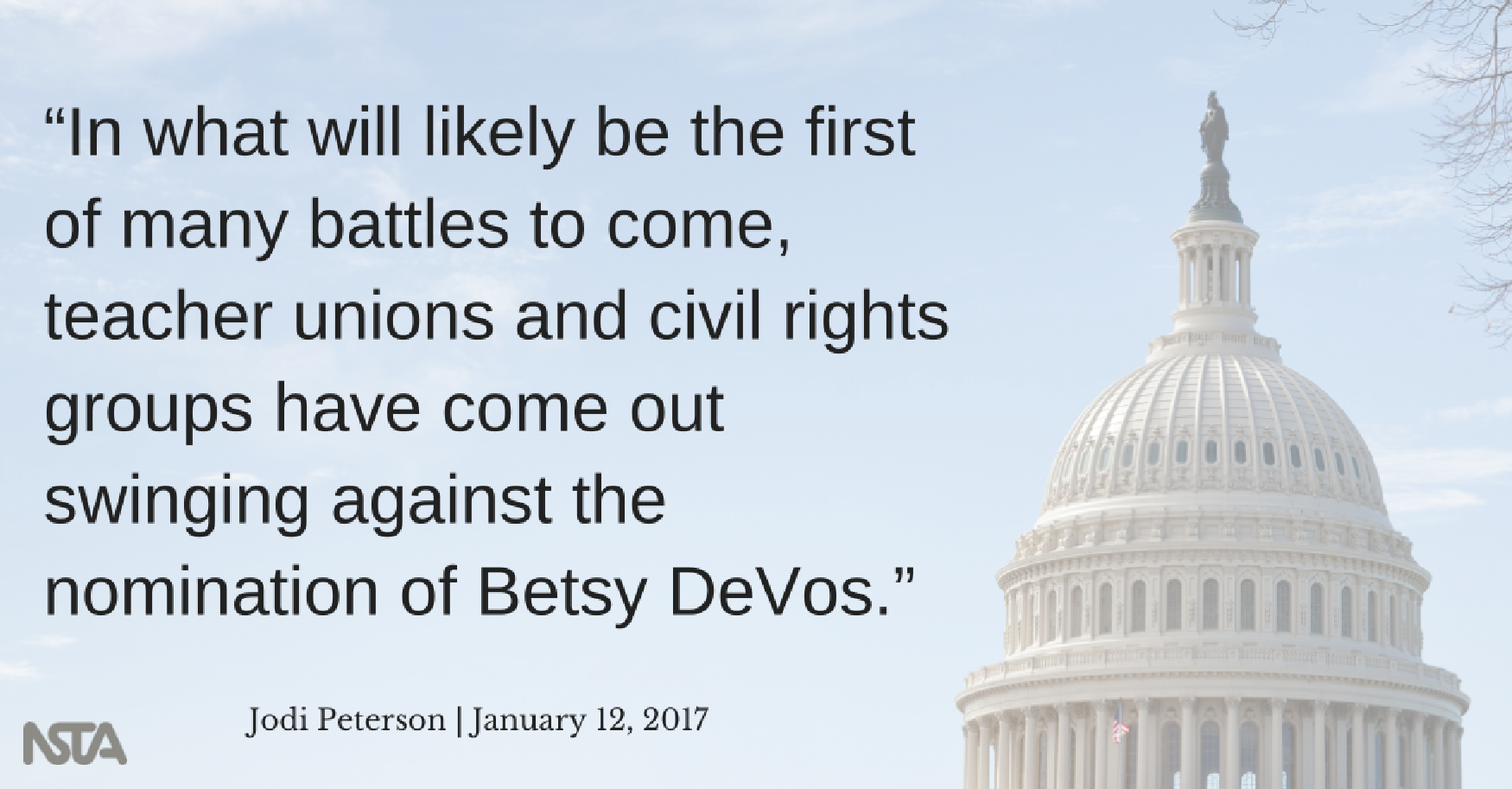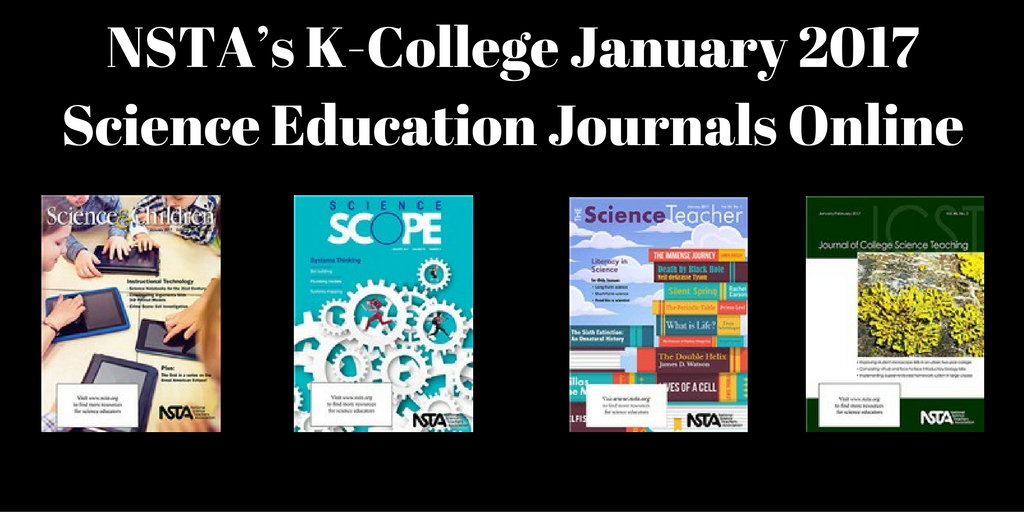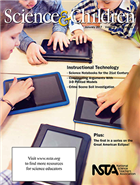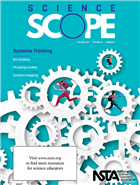What Are the National Academies and How Can You Use Them to Transform Your Teaching?
By Guest Blogger
Posted on 2017-01-17
During Recognition Week for the 2006 Presidential Award for Excellence in Mathematics and Science Teaching, awardees gathered in a Washington, DC, hotel for a federal agencies breakfast. While all 10 agencies present that morning provided awardees with an overview of their educational programs and outreach opportunities, it was The National Academies’ information that especially appealed to my desire to translate educational research into practice. I learned how The National Academies advances and fosters an awareness of the best cutting-edge science and its use in programs and reports. Unlike other Academies in many other countries, the U.S. Academies are not an arm of the federal government. The National Academies are a private, non-profit organization that depends on grants and contracts to support their work.
Later during Recognition Week, I received a copy of Taking Science to School, a consensus report from The National Academies during one of the professional development sessions. Besides the National Science Education Standards, this book was my first in depth exposure to a National Academies evidence-based consensus report. Upon receiving the report, a summary of major findings and conclusions was provided by one of the reports committee members. It was during this professional development session that I became aware of the four strands of science learning. (See October 2016 Science Scope for related article).
As I began thumbing through the table of contents and previewing chapters, I was drawn to the quote from Henri Poincare at the beginning of chapter 2, which states: “Science is built up of facts as a house is of stones, but a collection of facts is no more a science than a pile of stones is a house.” I was captivated by a subtitle on the same page, What is Science? and thought, since I was invited to Washington because of science teaching, I should read this section! I was perplexed however, when reading this section because my beliefs were challenged about the scientific method, an approach I had embraced in my teaching for years. I even had a poster in my classroom which described the method steps for direct experimentation. Upon additional reading, I learned this method treats science as a series of disembodied skills and fails to develop meaningful understanding. That feeling of cognitive dissonance and deeper reflection on practice has often led to an alteration of classroom behavior.
This new perspective in my thinking about some of the most tightly held and accepted premises of STEM and education that resulted from this report are typical of the findings, conclusions, and recommendations that emerge from National Academies’ consensus reports and publications from public workshops, symposia, and convocations. Founded in 1863 by an Act of Congress, The National Academies has served as an advisor to the nation on all matters of science, engineering, technology, and medicine. The original organization consisted of The National Academy of Sciences, but has since grown to now include The National Academies of Engineering and Medicine. The Academies are both honorific, where members elect other members who are recognized for lifetime achievement in these fields (most of the American Nobel Laureates named each year are members of one or more of the Academies), and they oversee the work of advising the nation. Additional details about how the Academies carry out their mission and work can be found here.
As a result of a clause in the original charter, all of the people who serve on The National Academies committees, prepare reports, and oversee the organization of workshops and symposia are volunteers, committing anywhere from six months to two years (depending on the project) in service to the American people. Each year approximately 6000 volunteers serve on some 500 to 600 ad hoc and permanent committees. The Academies publish about 250 reports each year, all available for free downloading at the website National Academies Press (http:/nap.edu). Visitors to this website also can sign up to receive notices about newly released reports in any area(s) of interest. A number of publications have been prepared for teacher practitioners. For example, the publication Taking Science to School also led to a practitioner volume for elementary and middle school teachers, Ready, Set, Science!: Putting Research to Work in K-8 Science Classrooms (available for free download here).
Since that breakfast a decade ago, I have relied on consensus reports from The National Academies to inform and guide my teaching. Turning to the National Academies for trusted advice based upon evidence, is now a natural part of my teaching practice. Other education-focused reports of The National Academies you may find meaningful in your work are:
- A Framework for K-12 Science Education: Practices, Crosscutting Concepts, and Core Ideas
- Developing Assessments for the Next Generation Science Standards
- STEM Integration in K-12 Education: Status, Prospects, and an Agenda for Research
- Monitoring Progress Toward Successful K-12 STEM Education: A Nation Advancing?
Author Kenneth L. Huff (khuff@ williamsvillek12.org) is the NSTA Division Director, Middle Level Science Teaching; a science educator at Mill Middle School in Williamsville, New York; and Vice Chair of The National Academies’ Teacher Advisory Council (http://nas.edu/tac).
Join NSTA today and receive Science Scope, the peer-reviewed journal just for middle school teachers; connect on the middle level science teaching list (members can sign up on the list server); or consider joining your peers for Meet Me in the Middle Day (MMITM) at the National Conference on Science Education in Los Angeles in the spring of 2017.
The mission of NSTA is to promote excellence and innovation in science teaching and learning for all.
Future NSTA Conferences
-
2017 National Conference
2017 STEM Forum & Expo
2017 Area Conferences
Follow NSTA
- Read more about What Are the National Academies and How Can You Use Them to Transform Your Teaching?
During Recognition Week for the 2006 Presidential Award for Excellence in Mathematics and Science Teaching, awardees gathered in a Washington, DC, hotel for a federal agencies breakfast. While all 10 agencies present that morning provided awardees with an overview of their educational programs and outreach opportunities, it was The National Academies’ information that especially appealed to my desire to translate educational research into practice. I learned how The National Academies advances and fosters an awareness of the best cutting-edge science and its use in programs and
Here's Why Space Nerds Need to Be at #NSTA17 LA
By Lauren Jonas, NSTA Assistant Executive Director
Posted on 2017-01-16
We didn’t invent the term space nerds; we just invited the two most interesting people on the planet who are proud to own it to speak at NSTA’s 2017 National Conference in Los Angeles: March 30–April 2.
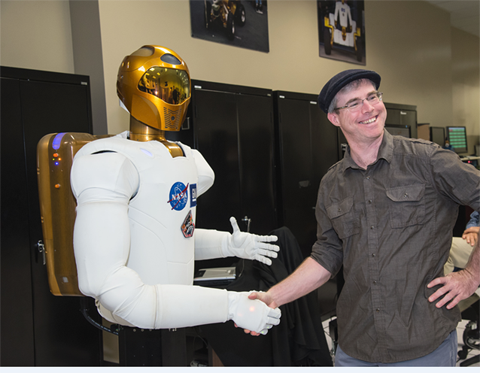
15 Early Birds Get to Dine With Andy Weir
Our keynote speaker is Andy Weir, author of the New York Times best seller The Martian, and a lifelong space nerd and devoted hobbyist of subjects like relativistic physics, orbital mechanics, and the history of manned spaceflight. Join us in LA to hear Weir speak on Thursday, March 30, from 9:15–10:30 AM.
Register by the earlybird deadline, February 3, and you’ll be automatically entered for a chance to win a special VIP experience. Fifteen lucky winners will receive:
- Invitation to join Andy for an exclusive dinner on Wednesday evening hosted by Penguin Random House
- Complimentary copy of the book and classroom kit
- VIP seating at the General Session
Special Preconference Presentation by Bill Nye

Don’t miss scientist, comedian, teacher, and author—Bill Nye as he shares “How nerds solve problems.” Bill’s ongoing mission is to change the world through science education. Join us to hear Bill’s Planetary Society Lecture on Wednesday, March 29, from 6:00–8:00 PM.
Meet Your Favorite NSTA Press Authors!
NSTA Press® Session: Argumentation in the Earth and Space Science Classroom
Thursday, March 30 8:00 AM – 9:00 AM
JW Marriott Los Angeles at L.A. LIVE, Diamond Ballroom Salon 3
Join us for a hands-on workshop to learn how to engage in scientific argumentation to support teaching in your classrooms. Sample activities from the leading NSTA books provided.
Presenter(s): Sharon Schleigh (East Carolina University: Greenville, NC)
FORMAT: Hands-On Workshop
GRADE LEVEL: 5 – 12
SUBJECT: Earth and Space Science
NSTA Press® Session: Next Time You See…
Friday, March 31 12:30 PM – 1:30 PM
JW Marriott Los Angeles at L.A. LIVE, Diamond Ballroom Salon 3
The author of the Next Time You See series from NSTA Press will share books and activities to inspire a sense of wonder about the natural world.
Presenter(s): Emily Morgan (Picture-Perfect Science: West Chester, OH)
FORMAT: Hands-On Workshop
GRADE LEVEL: PreK, K, 1 – 5
SUBJECT: General Science Education
NSTA Press® Session: Learning to Read the Earth and Sky, Explorations Supporting the NGSS
Friday, March 31 2:00 PM – 3:00 PM
JW Marriott Los Angeles at L.A. LIVE, Diamond Ballroom Salon 3
Earth scientists read stories written in the Earth. Join us in some investigative classroom lessons through which you and your students can apply the practices of science to reading the Earth.
Presenter(s): Russell Colson (Minnesota State University Moorhead: Moorhead, MN), Mary Colson (Horizon Middle School: Moorhead, MN)
FORMAT: Hands-On Workshop
GRADE LEVEL: 6 – 12, College
SUBJECT: Earth and Space Science
NSTA Press® Session: Solar Science = NGSS-Focused Solar Astronomy Experiences + Preparation for the All American Total Solar Eclipse
Saturday, April 1 9:30 AM – 10:30 AM
JW Marriott Los Angeles at L.A. LIVE, Diamond Ballroom Salon 3
NSTA recently published Solar Science, a solar astronomy curriculum resource that is NGSS-focused and prepares you for the 2017 solar eclipse. Come explore some of these effective learning experiences.
Presenter(s): Dennis Schatz (Pacific Science Center: Seattle, WA), Andrew Fraknoi (Foothill College: Los Altos Hills, CA)
FORMAT: Hands-On Workshop
GRADE LEVEL: 5 – 9
SUBJECT: Earth and Space Science
Out of This World Sessions, Trips, and Workshops
What else can Earth and space science fans do at NSTA’s National Conference? Here’s a sample; search the online session browser for more.
Blue Marble Matches
Thursday, March 30 8:00 AM – 9:00 AM
Los Angeles Convention Center, Kentia Hall Q
Connect NASA images of Earth and other planets with the evidence for geologic processes like weathering and erosion, while exploring the processes shaping our worlds.
Presenter(s): Veronica Leija (Learning Expert: Houston, TX), Brandon Hargis (NASA Johnson Space Center/Texas State University: Houston, TX)
FORMAT: Hands-On Workshop
GRADE LEVEL: 6 – 8
SUBJECT: Earth and Space Science
T-1: NASA Jet Propulsion Laboratory Morning Tour
Thursday, March 30 8:30 AM – 12:45 PM
Off-site, NASA Jet Propulsion Laboratory
T-3: NASA Jet Propulsion Laboratory Afternoon Tour
Thursday, March 30 12:00 PM – 4:15 PM
Off-site, NASA Jet Propulsion Laboratory (PM)
Ticket Price: $35 advance, preregistration only
Purchase tickets when you register online or on the LA Registration Form.
T-6: Griffith Observatory: Gateway to the Cosmos
Thursday, March 30 6:00 PM – 10:45 PM
Off-site, Griffith Observatory
Ticket Price: $35 advance; $40 on-site
Purchase tickets when you register online or on the LA Registration Form.
NASA’s “Eyes on the Solar System”: Bringing the Planets to Your Classroom
Friday, March 31 8:00 AM – 9:00 AM
Los Angeles Convention Center, Kentia Hall P
Bring the solar system to your classroom using this free computer-based model from NASA. Explore planets, spacecraft, and more!
Presenter(s): Rachel Zimmerman Brachman (NASA Jet Propulsion Laboratory: Pasadena, CA), Kevin Hussey (NASA Jet Propulsion Laboratory: Pasadena, CA)
FORMAT: Presentation
GRADE LEVEL: 5 – 12
SUBJECT: Earth and Space Science
F-1: Science and Endeavour Up Close at California Science Center
Friday, March 31 9:00 AM – 1:15 PM
Off-site, California Science Center
Ticket Price: $29 advance; $34 on-site
Purchase tickets when you register online or on the LA Registration Form.
F-2: The Columbia Memorial Space Center: Exploring 21st-Century STEM at a Historic NASA Site
Friday, March 31 9:30 AM – 1:30 PM
Off-site, Columbia Memorial Space Center
Ticket Price: $31 advance; $36 on-site
Purchase tickets when you register online or on the LA Registration Form.
Rocket Science and Engineering in High School: A STEM Approach
Friday, March 31 11:00 AM – 12:00 PM
JW Marriott Los Angeles at L.A. LIVE, Diamond Ballroom Salon 9
Come learn how to adapt complex concepts of aerospace engineering to high school students, in a hands-on STEM program.
Presenter(s): Dimitri Scripnic (Florida Polytechnic University: Lakeland, FL), Roberto Silva (Technological Institute of Aeronautics: Vila das Acacias, SP, Brazil)
FORMAT: Hands-On Workshop
GRADE LEVEL: 8 – 12, College
SUBJECT: Engineering-Technology-and the Application of Science, Earth and Space Science
Friday, March 31 2:00 PM – 3:00 PM
Los Angeles Convention Center, Kentia Hall P
Come learn how students in Washington State were able to work with scientists from a NASA Earth-observing mission to help with ground validation campaign!
Presenter(s): Dorian Janney (NASA Goddard Space Flight Center: Greenbelt, MD)
FORMAT: Presentation
GRADE LEVEL: 7 – 12
SUBJECT: Engineering-Technology-and the Application of Science, Earth and Space Science
STEM on Station
Friday, March 31 3:30 PM – 4:30 PM
JW Marriott Los Angeles at L.A. LIVE, Diamond Ballroom Salon 8
NASA Education Specialists demonstrate how to integrate research from the International Space Station into the biology classroom.
Presenter(s): Crystal Del Rosso (Paragon TEC: Houston, TX), Brandon Hargis (NASA Johnson Space Center/Texas State University: Houston, TX)
FORMAT: Hands-On Workshop
GRADE LEVEL: 7
SUBJECT: Life Science
Space Explorers: 25 Years of Inner-City Students Out-of-School-Time Explorations
Friday, March 31 5:30 PM – 6:00 PM
Los Angeles Convention Center, Kentia Hall R
Discover how to measure the universe with a digital camera and a Godzilla model, how fast your rods are compared to your cones in your eyes, and what happens when you connect astronomers and inner-city high school students.
Presenter(s): Randall Landsberg (Kavli Institute for Cosmological Physics: Chicago, IL)
FORMAT: Presentation
GRADE LEVEL: 7 – 12
SUBJECT: Informal Science Education, Earth and Space Science
NESTA and NSTA Aerospace Education Advisory Board Space Science Share-a-Thon
Saturday, April 1 8:00 AM – 9:00 AM
Los Angeles Convention Center, Petree Hall D
Join more than 20 NESTA members and other education specialists as they share their favorite NGSS-congruent classroom activities. Lots of free handouts!
Presenter(s): Paul Nordhaus (Harborside Academy: Kenosha, WI), Carla McAuliffe (TERC: Cambridge, MA)
FORMAT: Hands-On Workshop
SUBJECT: Earth and Space Science
Wonderful Watersheds!
Saturday, April 1 9:30 AM – 10:30 AM
JW Marriott Los Angeles at L.A. LIVE, Plaza 3
Get background on the science behind watershed regions and learn how NASA satellites collect data to better understand and protect these essential environments.
Presenter(s): Dorian Janney (NASA Goddard Space Flight Center: Greenbelt, MD)
FORMAT: Presentation
GRADE LEVEL: 2 – 12
SUBJECT: Life Science, Engineering-Technology-and the Application of Science, Earth and Space Science
Destination: NASA…21st-Century Skills and STEAM
Saturday, April 1 9:30 AM – 10:30 AM
Los Angeles Convention Center, Kentia Hall G
Join us and use NASA resources to collaboratively plan and implement integrated multidisciplinary units for K–5, like the one we’ll share “Destination: International Space Station!”
Presenter(s): Margaret Duke (Forest Lake Elementary School: Columbia, SC), Marian Scullion (Forest Lake Elementary School: Columbia, SC)
FORMAT: Hands-On Workshop
GRADE LEVEL: K, 1 – 5
SUBJECT: Earth and Space Science
Exploring Unknown Worlds Through Models, Images, and Data Analysis
Saturday, April 1 2:00 PM – 3:00 PM
Los Angeles Convention Center, Kentia Hall H
Explore an “unknown world” as a model for the way scientists explore planets, dwarf planets, moons, comets, and asteroids with telescopes and spacecraft.
Presenter(s): Larry Lebofsky (Planetary Science Institute: Tucson, AZ), Thea Canizo (Planetary Science Institute: Tucson, AZ), William Schmitt (The Science Center of Inquiry: Fountain Hills, AZ), Sanlyn Buxner (Planetary Science Institute: Tucson, AZ)
FORMAT: Hands-On Workshop
GRADE LEVEL: 3 – 8
SUBJECT: Earth and Space Science
 Want more? Browse the program preview, or check out more sessions and other events with the LA Session Browser/Personal Scheduler. Follow all our conference tweets using #NSTA17, and if you tweet, please feel free to tag us @NSTA so we see it! Need to request funding or time off? Download this letter of support.
Want more? Browse the program preview, or check out more sessions and other events with the LA Session Browser/Personal Scheduler. Follow all our conference tweets using #NSTA17, and if you tweet, please feel free to tag us @NSTA so we see it! Need to request funding or time off? Download this letter of support.
The mission of NSTA is to promote excellence and innovation in science teaching and learning for all.
Future NSTA Conferences
2017 National Conference
2017 STEM Forum & Expo
Follow NSTA
We didn’t invent the term space nerds; we just invited the two most interesting people on the planet who are proud to own it to speak at NSTA’s 2017 National Conference in Los Angeles: March 30–April 2.
Science classroom libraries
By Mary Bigelow
Posted on 2017-01-13
I am a new elementary librarian, and I want to prioritize science nonfiction. I’m looking for suggestions to help teachers who often do not have time to collect books from the library. I also n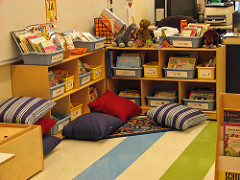 eed ideas for books to purchase. — J., New York
eed ideas for books to purchase. — J., New York
I spoke with a librarian colleague, who did what you are considering. She suggested asking teachers for a schedule of topics they work on throughout the year. She had a large plastic tub for each classroom where she put corresponding books covering a range of reading levels. For each unit, the classroom received a new set of supplementary books. She often had older students or parent volunteers prepare the boxes.
To find appropriate titles for all grade levels, I have used the NSTA website. Outstanding Science Trade Books for Students K–12 and the Best STEM Books K-12 contain lists compiled by NSTA in association with the Children’s Book Council. The titles are listed by year and include an annotated description of each book. NSTA Recommends also has monthly updates in the NSTA journals.
All of these titles are also in the second source, NSTA Recommends. This is a broader, searchable list that includes reviews of books and other media. The reviews are written by science educators and can be searched by format (e.g., print, kits, DVDs), keywords (e.g., weather, machines, insects), and grade level (K through college). The lists can be exported as Excel spreadsheets.
The School Library Journal also has a list of recommended Science and Nature Books for Kids.
Some teachers might be willing to help you select the books or suggest topics—perhaps during a faculty meeting or workshop on science and reading.
Photo: https://farm2.staticflickr.com/1033/1333506858_2f1392116d_m_d.jpg
Health Wise: Why Teens Need the HPV Vaccine
By sstuckey
Posted on 2017-01-12
About 79 million Americans have human papillomavirus (HPV), the nation’s top sexually transmitted disease. “Nearly all sexually active men and women get it at some point in their lives,” according to the U.S. Centers for Disease Control and Prevention (CDC 2016a).
HPV usually goes away on its own. But sometimes, HPV can cause genital warts or cancer, even decades after an individual has sex with an infected person. HPV can cause cancer of the cervix, vulva, vagina, penis, or anus, as well as oral cancers.
High school students are especially at risk for contracting sexually transmitted diseases (STDs) (Bratsis 2014). Each year, about 14 million people, including teens, become infected with HPV, and more than 11,000 women get cervical cancer due to HPV, the CDC says (2016a).
The CDC and the American Academy of Pediatrics (AAP 2015) recommend that all boys and girls ages 11–12 get HPV vaccinations, which are given in a series of two or three shots. According to the CDC (2015), the vaccine targets the most common of the more than 150 types of HPV.
“Teen boys and girls who did not start or finish the HPV vaccine series when they were younger should get it now,” the CDC recommends (CDC 2016b). “Young women can get the HPV vaccine through age 26, and young men can get vaccinated through age 21. The vaccine is also recommended for any man who has sex with men through age 26.”
As of 2015, 49.8% of boys ages 13–17 had gotten at least one of the recommended three doses, up 7.9 percentage points from 2014. More than 60% of girls had gotten at least one dose of the vaccine, up 2.8 percentage points from 2014 (CDC 2016c).
Unfortunately, many parents may be wary of the HPV vaccine. Only 21% of parents said laws requiring the vaccine for students were a “good idea,” but that number rose to 57% if there were an “opt-out” provision, according to a national study (Calo et al. 2016). The lead researcher of the study, William Calo, told ABC news that an opt-out provision could weaken vaccination efforts (Chevisnky 2016).
In addition, “One of the most surprising findings of the study is that 60% of people don’t believe the vaccine is effective in preventing cervical cancer,” Calo said (Chavinsky 2016).
But studies do highlight the vaccine’s effectiveness. One study (Bernard et al. 2016) found that seven years after the HPV vaccine was introduced, the rate of moderate cervical precancerous lesions declined 54% among 15- to 19-year-old teens in New Mexico. The study also showed a 39% decline in moderate cervical precancers among 20- to 24-year-old women in New Mexico (Bernard et al. 2016).
Michael E. Bratsis is senior editor for Kids Health in the Classroom (kidshealth.org/classroom). Send comments, questions or suggestions to mbratsis@kidshealth.org.
On the web
HPV infographic: http://bit.ly/2eq8VuL
Article for students: www.teenshealth.org/en/teens/hpv-vaccine.html
References
American Academy of Pediatrics (AAP). 2015. AAP updates HPV vaccine recommendations after licensure of HPV9. www.aappublications.org/content/36/6/16
Bernard, B., P.E. Castle, S.A. Jenison, et al. 2016. Population-Based incidence rates of cervical intraepithelial neoplasia in the human papillomavirus vaccine era. Journal of the American Medical Association Oncology. http://bit.ly/2eq83X5
Bratsis, M.E. 2014. Health Wise: Teens and STDs. The Science Teacher 81 (3): 74–75. http://bit.ly/2g4e9ga
Calo, W.A., M.B. Gilkey, P.D. Shah, J.L. Moss, and N.T. Brewer. 2016. Parents’ support for school-entry requirements for human papillomavirus vaccination: A national study. Cancer Epidemiology, Biomarkers & Prevention. http://bit.ly/2fFz5He
Centers for Disease Control and Prevention (CDC). 2015. What is HPV? http://bit.ly/2bpgbpJ
Centers for Disease Control and Prevention (CDC). 2016a. Genital HPV infection—Fact sheet. http://bit.ly/1qN5PC6
Centers for Disease Control and Prevention (CDC). 2016b. HPV Vaccines: Vaccinating your preteen or teen. www.cdc.gov/hpv/parents/vaccine.html
Centers for Disease Control and Prevention (CDC). 2016c. National, regional, state, and selected local area vaccination coverage among adolescents aged 13–17 years–United States, 2015. http://bit.ly/2eq74WW
Chevinsky, J. ABC News. 2016. Parents Want ‘Opt-Out’ Option for HPV Vaccine, Study Finds. August 19. http://abcn.ws/2eXf4tM
Editor’s Note
This article was originally published in the January 2017 issue of The 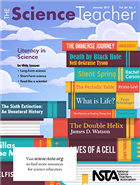 Science Teacher journal from the National Science Teachers Association (NSTA).
Science Teacher journal from the National Science Teachers Association (NSTA).
Get Involved With NSTA!
Join NSTA today and receive The Science Teacher,
the peer-reviewed journal just for high school teachers; to write for the journal, see our Author Guidelines, Call for Papers, and annotated sample manuscript; connect on the high school level science teaching list (members can sign up on the list server); or consider joining your peers at future NSTA conferences.
Legislative Update
Unions and Civil Rights Groups Strongly Oppose DeVos Nomination
By Jodi Peterson
Posted on 2017-01-12
In what will likely be the first of many battles to come, teacher unions and civil rights groups have come out swinging against the nomination of Betsy DeVos to become U.S. Secretary of Education while Republican governors are applauding President-elect Trump for his “inspired choice” to reform federal education policy.
The Senate confirmation hearing for DeVos, originally scheduled for January 11, was postponed one week and is now scheduled for January 17 at 5 p.m. Senator Lamar Alexander (R-TN), chair of the Senate Health Education Labor and Pensions (HELP) Committee, and Sen. Patty Murray (D-WA), HELP’s ranking Democrat, said in a statement the hearing change was made to accommodate the Senate schedule. Later media reports indicated the hearing date was pushed back because the ethics check on DeVos was not completed.
After meeting with DeVos last week, Sen. Murray said in a statement, “I continue to have serious concerns about her long record of working to privatize and defund public education, expand taxpayer-funded private school vouchers, and block accountability for charter schools.”
Sen. Alexander told The Chattanoogan, “Betsy DeVos and I had a great meeting today, and she is going to make an excellent Secretary of Education. I’m looking forward to her hearing because I know she will impress the Senate with her passionate support for improving education for all children.”
In a letter to Sen. Alexander, 18 Republican governors said that DeVos was an “inspired” choice. “Betsy DeVos will fight to streamline the federal education bureaucracy, return authority back to states and local school boards, and ensure that more dollars are reaching the classroom…Betsy DeVos also is a passionate supporter of increasing parental engagement in their children’s education and of harnessing the power of competition to drive improvement in all K-12 schools, whether they be public, private or virtual.”
The Leadership Conference on Civil and Human Rights—a coalition of more than 200 national organizations—said in a letter, “We reject the notion that children are well served by the dismantling of a public school system that serves 90 percent of all American students or by the elimination of civil rights protections that require the federal government to intervene when students are discriminated against.”
In a Huffington Post piece, AFT President Randi Weingarten called DeVos “a billionaire with an agenda” who could reignite “education wars” between Democrats and Republicans.
The NEA maintains that “by nominating Betsy DeVos, the incoming Trump administration is demonstrating it does not share our vision of public education and what works best for students, parents, and communities.”
More about Betsy DeVos in this New York Times article.
The First 100 Days and Beyond—What’s in Store for Education?
There is lots of talk about what the first 100 days of the Trump administration will look like. Many expect the new Administration will reverse many Obama-era regulations, repeal Obamacare and replace it with a Republican plan, and introduce tax reform.
In education, two education-related regulations likely to be overturned deal with teacher preparation and the ESSA state and education accountability. More here on that.
Although not likely in the first 100 days, look for efforts to scale back the Department of Education Office of Civil Rights.
Many also anticipate some kinds of initiative to expand private school choice, although it is possible this could be done through the ESSA State plans now being developed.
On Capitol Hill, members of Congress will be paying keen attention to the Implementation of ESSA. Two education bills that will likely come up include the the Higher Education Act, which was last comprehensively reauthorized in 2008, and the rewrite of the Perkins Act, which oversees federal funding of career and technical education.
Update on ESSA Implementation
On January 6, the Education Department posted new guidelines for states to help them develop consolidated state plans, state and local report cards, and determine graduation rates under the new federal education law, the Every Student Succeeds Act. Links to the guidance are below.
Consolidated State Plan guidance
State and Local Report Cards Guidance
High School Graduation Rate Guidance
States are allowed to submit their consolidated State plan or individual program plans on April 3, 2017, or on September 18, 2017. Do you know what your state is doing to implement ESSA? Learn more here about how to make STEM a priority in ESSA.
A reminder that the U.S. Department of Education is hosting a series of webinars on the ESSA, Title IV, Part A Student Support and Academic Enrichment grant. More information on the webinars is below. These grants will allow STEM activities.
Thursday, January 26, 2017 at 2 p.m. eastern
Role of State Educational Agencies; Local Application Requirements; and Implementing Effective SSAE Program Activities
Registration: https://safesupportivelearning.ed.gov/node/8739/0/register
Thursday, February 9, 2017 at 2 p.m. eastern:
Allowable Activities to Support Well-Rounded Educational Opportunities; Safe and Healthy Students; and the Effective Use of Technology
Registration: https://safesupportivelearning.ed.gov/node/8740/0/register
And finally, the Department of Education is seeking highly qualified individuals to serve as peer reviewers of State plans required under ESSA. For more information, including a link to the application, visit https://www2.ed.gov/admins/lead/account/stateplan17/index.html.
American Innovation and Competitiveness Act <Finally> Becomes Law
Before the Senate adjourned prior to the Christmas break, on Friday, December 16, 2016 they passed S. 3084, the American Innovation and Competitiveness Act (AICA). President Obama signed the bill into law on January 6, 2017.
This legislation is the successor to the America COMPETES Act, which sets policy for a number of federal STEM education programs and for the National Science Foundation, the National Institute of Standards and Technology, the Office of Science and Technology Policy, and the Department of Energy Office of Science.
The House version of this bill was largely controversial, and it was assumed that the Congressional clock had run out and that this legislation would not pass prior to adjournment of the 114th Congress. However, on December 10, 2016 the Senate passed a modified version of the bill before leaving town that had both bicameral and bipartisan support. The House had already adjourned but still passed the AICA on December 16, 2016 by unanimous consent (both chambers of Congress can bypass their procedural rules and pass legislation with no objections.)
In regard to STEM education, the key new law authorizes a restructure of NSF’s Robert Noyce STEM teacher program, including a new program to partner recently retired STEM professionals with STEM teachers; creates a STEM education advisory panel of non-Federal employees to advise the President and the Committee on STEM education (CoSTEM) on federal STEM programs and STEM policy; asserts that NSF continue grants to broaden participation in STEM; provides continuing K-12 computer science grants; and encourages on-going partnerships between NSF and institutions involved in informal STEM learning, institutions of higher education, and education research centers.
Stay tuned, and watch for more updates in future issues of NSTA Express.
Jodi Peterson is Assistant Executive Director of Legislative & Public Affairs for the National Science Teachers Association (NSTA) and Chair of the STEM Education Coalition. Reach her via e-mail at jpeterson@nsta.org or via Twitter at @stemedadvocate.
The mission of NSTA is to promote excellence and innovation in science teaching and learning for all.
Follow NSTA
P-47 and the Double Wasp Engine
By Judy Elgin Jensen
Posted on 2017-01-12
 In “P-47 and the Double Wasp Engine,” fighter pilot Benjamin Cassiday emphatically states, “It was an aircraft that could get you home.” While adrenaline filled the veins of these courageous WWII pilots, likely there was no greater rush than when they touched down on their home runway.
In “P-47 and the Double Wasp Engine,” fighter pilot Benjamin Cassiday emphatically states, “It was an aircraft that could get you home.” While adrenaline filled the veins of these courageous WWII pilots, likely there was no greater rush than when they touched down on their home runway.
Driven by the Pratt and Whitney R-2800 Double Wasp air-cooled radial engine, the huge P-47 was able to successfully compete against much smaller adversaries. Find out how in P-47 and the Double Wasp Engine—one of 10 posted videos in the Chronicles of Courage series. The 20-video series from the partnership of NBC Learn and Flying Heritage Collection uses the collection’s WWII airplanes and aviation technology as their focal point.
Like several of the NSTA-developed lesson plans in this series, this plan gives you ideas for prompting students to use paper airplanes as their experimental tool. You’ll see an example of a possible design that could explore the relationship between power and weight whereby students add weight to the wings or fuselage, change the power generated by the rubber-band propeller, or use different sized propellers. Internet references are included to support students as well.
With such an investigation, are you concerned you won’t have the right answer for students? That’s one of the beauties of engineering design investigations—you don’t have to because there is no “right answer.” The best design is the one that performs optimally given the criteria and constraints. Chances are more than one group will end up with optimal design solutions. If so, give students a chance to critique all of the solutions and make claims based on evidence about which one they think is “best.” Witness the effects of your students’ adrenaline as they enthusiastically design and fly their paper airplane solutions.
Video
Chronicles of Courage: Stories of Wartime and Innovation “P-47 and the Double Wasp Engine” explores how the much larger and heavier P-47 Thunderbolt and its extremely powerful engine allows the hulking fighter to be competitive at all altitudes.
STEM Lesson Plan—Adaptable for Grades 7–12
Chronicles of Courage: Stories of Wartime and Innovation “P-47 and the Double Wasp Engine” provides strategies for extracting information from video content and challenging students to explore further plus support for building science literacy through reading and writing.
Flying Tigers
By Judy Elgin Jensen
Posted on 2017-01-10
 One of the most familiar WWII airplanes carries the trademark of the Flying Tigers—a long nose painted with a menacing shark mouth. While the Flying Tigers were a hotshot fighter group, the pilots had to develop new tactics to outfly their Japanese adversary—the Nakajima Ki-43 Hayabusa, or what the Americans call the “Oscar.”
One of the most familiar WWII airplanes carries the trademark of the Flying Tigers—a long nose painted with a menacing shark mouth. While the Flying Tigers were a hotshot fighter group, the pilots had to develop new tactics to outfly their Japanese adversary—the Nakajima Ki-43 Hayabusa, or what the Americans call the “Oscar.”
Why? Find out in Flying Tigers—one of 10 posted videos in the Chronicles of Courage series. The 20-video series from the partnership of NBC Learn and Flying Heritage Collection uses the collection’s WWII airplanes and aviation technology as their focal point.
Listen to experts describe the innovations of these aircraft and the pilots themselves talk how the plane performs in the air. Then turn students loose to “mess around” with materials as they generate questions to answer through investigation. The NSTA-developed lesson plan will give you a leg up on that, with suggested materials and a few directions investigations might take.
Consider developing a guide to support students as they document what happens when they manipulate materials. Include a place where students write down their questions specifically. Then encourage students to take some chances and try different things with the materials as a way to generate more questions.
Take a moment to look at this video and the array of suggestions for using it in your classes. Can’t make an immediate connection with this one? No worries. Take a look at one of the others. We’re sure you’ll find a fit that excites your students and brings those textbook concepts to life.
Video
Chronicles of Courage: Stories of Wartime and Innovation “Flying Tigers” presents two very different aircraft. The Oscar is light and nimble with especially designed butterfly flaps to give it a turning advantage over it adversaries. The Tomahawk was rugged and strong, which allowed it to dive quickly.
STEM Lesson Plan—Adaptable for Grades 7–12
Chronicles of Courage: Stories of Wartime and Innovation “Flying Tigers” provides strategies for extracting information from video content and challenging students to explore further plus support for building science literacy through reading and writing.
Children use technology to send messages
By Peggy Ashbrook
Posted on 2017-01-08
 Children like to share their work and tell their families what they do at school or at other times when they are not together. While babysitting for a friend, I appreciated her 2-year-old child’s excitement when she discovered that a toy firetruck had a button to push to turn on (and off) a siren. “Tell Mommy, fire engine has a siren!” she exclaimed several times. I asked her if she would like to write a message to her mother telling her about this and she immediately went to her art shelf and came back with an erasable magnetic drawing board. First she drew the firetruck, then “Me” and then “Mommy,” naming each illustration as she drew it. I took a photo, before the message was erased, to share the moment with my friend when she returned (see it labeled it here). These two technologies, the magnetic drawing board and camera, allowed a child to communicate with her parent, and her parent to be part of her child’s developing understanding of symbols.
Children like to share their work and tell their families what they do at school or at other times when they are not together. While babysitting for a friend, I appreciated her 2-year-old child’s excitement when she discovered that a toy firetruck had a button to push to turn on (and off) a siren. “Tell Mommy, fire engine has a siren!” she exclaimed several times. I asked her if she would like to write a message to her mother telling her about this and she immediately went to her art shelf and came back with an erasable magnetic drawing board. First she drew the firetruck, then “Me” and then “Mommy,” naming each illustration as she drew it. I took a photo, before the message was erased, to share the moment with my friend when she returned (see it labeled it here). These two technologies, the magnetic drawing board and camera, allowed a child to communicate with her parent, and her parent to be part of her child’s developing understanding of symbols.
Photographs helped me share another child’s work with his parents. As a child care provider in my home I often had water color paint sets available for the four-year-olds. One child was very interested in layering paint colors to mix and blend. Beginning with one color he would add more and more colors to the page until it was a solid page of rich black with no shapes or lines to show how the work progressed. After several days of sending home all black paintings I took a series of photos as the child worked to show his parents what he was working on so they could also enjoy the process.
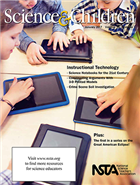 In the January 2017 issue of Science and Children, I wrote about using technologies available in your program for children to create a message about their interests and work to send, or carry, home. In the Editor’s Note, Linda Froschauer talks about the “selection dilemma” as educators look for “technology that provides the best opportunities for students to access knowledge, build science and engineering skills, and function within a framework of scientific investigation.”
In the January 2017 issue of Science and Children, I wrote about using technologies available in your program for children to create a message about their interests and work to send, or carry, home. In the Editor’s Note, Linda Froschauer talks about the “selection dilemma” as educators look for “technology that provides the best opportunities for students to access knowledge, build science and engineering skills, and function within a framework of scientific investigation.”
It will be some time before the 2-year-old becomes the “Empowered Learner,” “Digital Citizen,” or “Global Collaborator” envisioned in the International Society for Technology Education’s (ISTE) National Educational Technology Standards for Students but she is already a “Knowledge Constructor,” “Innovative Designer,” and “Creative Communicator” using tools that preceded digital tools. There is still much to learn about young children’s use of technology and the impact it can have on their education.
In a recent episode of ‘black•ish, “Their Eyes Were Watching Screens,” parents were confronted with the fact that they didn’t really know how their children were using technology and what they were viewing. After an initial feeling of panic they found a way to “make technology your family time friend!” Educators’ and parents’ questions about children’s use of media technologies are of interest to researchers at institutions such as The Center on Media and Human Development at Northwestern University, The Erikson Institute’s Technology in Early Childhood (TEC) Center, and The Joan Ganz Cooney Center at Sesame Workshop, and pediatric doctors (Kabali and all 2015). Continuing research will help us be intentional in our choices of technology–old school paper and crayons or digital technology–to help young children create learning moments and document it.
Here are a few additional resources to help early childhood educators and families “make technology our friend” and an appropriate, effective tool for young children.
Lisa Guernsey’s and Michael Levin’s website for their book, Tap, Click, Read: Growing Readers in a World of Screens, has videos about programs supporting young readers and links to app reviewers to help families and educators choose effective tools.
Tech in the Early Years, edited by Chip Donohue and published by Routledge and the National Association for the Education of Young Children (NAEYC), is “a thought-provoking guide to effective, appropriate and intentional use of technology with young children.” I love their statement about Mr. Rogers and the use of his quote: Fred Rogers serves as a reminder of what is most important and a perfect stepping off point for your reading, learning and teaching.
“Computers can be useful machines, especially when they help people communicate in caring ways with each other…” Fred Rogers, 1996.
The key messages in Technology and Interactive Media as Tools in Early Childhood Programs Serving Children from Birth through Age 8, NAEYC’s joint position statement with The Fred Rogers Center for Early Learning and Children’s Media at Saint Vincent College, are:
- When used intentionally and appropriately, technology and interactive media are effective tools to support learning and development.
- Intentional use requires early childhood teachers and administrators to have information and resources regarding the nature of these tools and the implications of their use with children.
- Limitations on the use of technology and media are important.
- Special considerations must be given to the use of technology with infants and toddlers.
- Attention to digital citizenship and equitable access is essential.
- Ongoing research and professional development are needed.
Learn more about these key messages and explore “Selected Resources on Technology in Early Childhood Education” provided by NAEYC.
Communities and education systems must find a way to provide paid hours for early childhood educators who are already in the workforce to be as intentional about the use of technology and interactive media as we are with any choice we make in scheduling young children’s day. The education of the developing minds and abilities of young children are too important for us to, as Froschauer observed, feel that technology is “simply be happening to [us] rather than being carefully considered and selected.”
Lab debriefing options
By Mary Bigelow
Posted on 2017-01-07
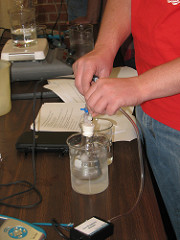 My ninth grade students enjoy doing labs. But afterward, most do not participate in the debriefing. How can I improve this? —A., Washington
My ninth grade students enjoy doing labs. But afterward, most do not participate in the debriefing. How can I improve this? —A., Washington
You could try an alternative to teacher-led discussions. Here’s one that worked with my students.
Instead of you asking questions, assign one team of students to present their results to the class in a panel format. Before the activity, choose one team to present. You could assign members’ roles ensuring participation: Person 1 – Introduce the team and present the question, problem, or hypothesis. Person 2 – Summarize the procedure. Person 3 – Provide a display and description of the data, observations, or results, incorporating classroom technology. Person 1 (again) – Relate the results back to the question or hypothesis. Person 4 – Note any questions the team had, how the investigation could or should be done differently, and take questions from the audience.
Give the team time at the end of the activity or at the beginning of the next class to prepare. Rotate roles so the students are doing different components of the report the next time they present.
At first, you may have to model how to summarize and how to make an effective presentation (my students enjoyed it when I modeled an ineffective one, too). You may have to model how to contribute as a respectful audience member and suggest types of questions and discussion prompts: Compare their results to yours. How are they similar? Different? And as a member of the audience, you get to ask questions, too.
This may take more time, but students also get the opportunity to be presenters.
NSTA’s K-College January 2017 Science Education Journals Online
By Korei Martin
Posted on 2017-01-05
Want to use technology to enhance your elementary classroom? Looking to get your middle level students to understand how different parts in a system interact? Want ways to help your high school students to think critically? Or do you just need want resources to create case studies for your college students? The January K-College journals from the National Science Teachers Association (NSTA) have the answers you need. Written by science teachers for science teachers, these peer-reviewed journals are targeted to your teaching level and are packed with lesson plans, expert advice, and ideas for using whatever time/space you have available. Browse the January issues; they are online (see below), in members’ mailboxes, and ready to inspire teachers.
Students are more than digital natives; they are embedded in technology. Thus, teachers must frequently use technologically advanced tools in the classroom. This requires a change in approach and assessment. In this issue, students learn science with technology, which enhances both subjects.
Featured articles (please note, only those marked “free” are available to nonmembers without a fee):
- Science Notebooks for the 21st Century
- What’s Lurking in Our Lake?
- Zooming in on Science
- Free – Constructing Arguments With 3-D Printed Models
- Free – Editor’s Note: The Dilemmas of Technology
- Table of Contents
Understanding how the different parts of a system interact is an important first step in trying to solve the complex problems facing our world today. We hope the activities in this issue of Science Scope will get your students’ gears turning as they explore how systems can lead to solutions both in the classroom and in the real world.
Featured articles (please note, only those marked “free” are available to nonmembers without a fee):
- Building Bots to Develop Systems Thinking
- Call the Plumber! Engaging Students With Authentic Engineering Design Practices
- Classic Lessons 2.0: Falling Into Understanding
- Free – From the Editor’s Desk: Systems Thinking Solutions
- Free – Using Systems Mapping to Plan Scientific Investigations
- Table of Contents
Today’s students are dazzlingly fluent digital natives. They text, blog, Snapchat, Instagram, and Facebook. They use search engines; they ask their smartphones for answers to questions that, in a different era, might have required a trip to the library. But a recent study of middle school, high school, and college students found that many students—over 80% in some cases—couldn’t tell the difference between an advertisement and a news story, distinguish between a real and fake news source, identify bias in a tweet, or determine if a website could be trusted. It is imperative that students learn to think critically and engage in argument based on reliable evidence. What better place for them to learn this than in science class? This issue offers tips and techniques for engaging students in reading critically—including classic science books such as those on this month’s cover—and writing clearly.
Featured articles (please note, only those marked “free” are available to nonmembers without a fee):
- Read Like a Scientist
- Short-Form Science
- Text Savvy
- Free – Long-Form Science
- Free – Health Wise: Why Teens Need the HPV Vaccine
- Table of Contents
Journal of College Science Teaching 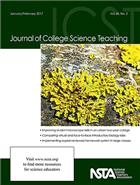
If you are interested in curricula that mirror the interdisciplinary and collaborative research environments of practicing scientists, see how several authors attempted to implement what they termed the Chemistry-Genetics Course Collaborative, a cotaught offering of a human genetics course with an honors introductory chemistry course. Want to create case studies that are more interesting? Read Clyde Freeman Herreid’s article in the Case Study column that describes the secret ingredient that sets great case studies apart: They have personality. And in the Research and Teaching department, find out how models from the literature and iterative feedback were used to help students generate proper data figures for use in posters.
- A Discipline-Specific Approach to the History of U.S. Science Education
- Digital Badges in Science: A Novel Approach to the Assessment of Student Learning
- Implementation of Peer-Reviewed Homework Assignments
- Free – What Makes Us Who We Are? Investigating the Chemistry Behind Genetics in an Interdisciplinary Course for Undergraduate Students
- Sesame Street Picnic: An Introductory Activity to Claims, Evidence, and Rationale
- Table of Contents
Get these journals in your mailbox as well as your inbox—become an NSTA member!
The mission of NSTA is to promote excellence and innovation in science teaching and learning for all.
Follow NSTA



